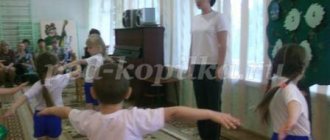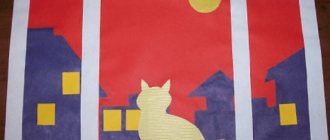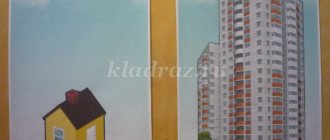PROJECT TO FAMILIARIZE PRESCHOOL CHILDREN WITH THE WORK OF ADULTS IN A PREPARATORY SCHOOL GROUP
Transcript
1 municipal budgetary preschool educational institution kindergarten 253 of the Samara city district PROJECT TO FAMILIARIZE PRESCHOOL CHILDREN WITH THE WORK OF ADULTS IN A PREPARATORY SCHOOL GROUP Prepared and conducted by: teacher Niselovskaya Maria Viktorovna SAMARA, 2015
2 Topic “Labor education. Introducing preschoolers to the work of adults” Topic questions. 1. Introducing children to various professions. 2. Formation of primary labor skills in preschoolers. 3. Methodological support for initial career guidance. Problem. Preschool children know little about professions. Fostering respect for working people, interest in the natural and man-made world. in which the child will live is the only opportunity to form a conscious attitude towards work and a desire for creative activity. What is needed to solve this problem: a long-term plan to familiarize children with professions; visual plan and methodological material; information about the most in-demand professions in the city. Project duration: academic year (for each age group). Objectives To contribute to the expansion and clarification of ideas about different types of work. Create conditions for consolidating ideas about labor actions performed by adults; about the results of labor; about the equipment, tools and materials needed for work. Arouse children's curiosity and interest in adult activities. Promote positive attitudes and respect for work. Activities of teachers 1. Development of methodological recommendations for introducing children to professions (for each age group). 2. Creation of approximate lesson notes to familiarize children with professions (for each age group). 3. Studying calendars in order to obtain information about professional holidays. 4. Making a layout of the profession calendar. The calendar is a notebook consisting of 12 sheets (according to the number of professions studied per year). Each age group has its own list of professions recommended for introduction. On each sheet there is an image of symbols of a certain profession. The calendar is accompanied by a manual for educators, consisting of lesson notes, materials for conversations, games, competitions, excursions and other forms of work.
3 Children's activities Excursions, conversations, holidays, classes, competitions, role-playing games, various types of work activities, reading fiction, designing, prototyping, collecting. Activities of parents Conversations with children, stories about professions, walks and excursions for educational purposes, assistance in creating collections, layouts, newspapers and albums “Who should I be?” Result of the work A new system of labor education in preschool educational institutions has been created. Children had the opportunity to find friends with similar interests, and their individual creative abilities were revealed. Positive dynamics in the development of labor skills and abilities of preschoolers can be traced. As a result of the project, teachers have developed positive motivation and skills in mastering the methodology of playful interaction with children. Methodological recommendations have been developed for introducing children to professions. Profession calendars have been created for all age groups; notes of thematic classes. A computer presentation of the project was prepared using the Intel program. Education for the future." An exhibition of children's works "Who to be?" Game models of “Professions in my city” were made. The gaming development environment is replenished with role-playing games to familiarize children with professions. Presentation form. City seminar on the topic “The work of adults and the social education of preschool children” (Tolyatti, November 2003). Lesson notes for introducing children to professions Profession architect “Architect's Workshop” Purpose. Continue to develop children's ideas about the profession of an architect. Develop constructive abilities, associative thinking and imagination. Develop communication skills, speech and behavioral etiquette. Preliminary work. Conversations about the professions of architect and builder, excursions, display of illustrative material. Reading: V.V. Mayakovsky “Who to be?”, D. Rodari “What do crafts smell like”, etc. Conducting games, pantomimes and sketches. Teamwork to create a city street layout. Vocabulary work. Architectural terms and concepts.
4 Material. Cards with symbols (tree, train, ball, etc.); geometric shapes cut out of cardboard (triangles, squares, etc.); building material (cubes, Legos, etc.); flannelograph for each child. Progress of the lesson Teacher. Would you like to imagine what our city will be like in the future? The mayor's office announced a competition to create the best project for a city in poverty. Are you ready to participate in it? (Children agree.) 1st child. What does it cost us to build a city? Let's draw and live! 2nd child. No matter how it is. If you build a city without a good plan, you won't have any worries later. Educator. And so that there are fewer worries, there is a respected profession in the world - an architect. Let's play architects! We will come up with a street for the city of the future. Hands out cards with symbols and geometric shapes cut out of cardboard to children. Use symbols to imagine what you will build. Create "blueprints" on your screens using geometric shapes. Children come up with and lay out “schemes” of objects on flannelgraphs. You've got the building plans. Tell me, what are they for? (Architects come up with buildings, make drawings, and builders build houses based on the drawings.) The teacher invites the children to talk about their drawings. 1st child. I have a picture of a tree, which means I need to design a park, but there are parks in the city. It would be nice if we had a water park. Everyone could relax, ride the slides, swim in the pool. 2nd child. I depicted a planetarium. With the help of special glasses you can see distant stars and planets there. 3rd child. And I came up with a bowling sports club for children. Educator. Now I suggest you pay for these wonderful ideas and build a city street. You received gifts: Bricks, bars and arches. You need to build a city so that everyone can live happily. Build quickly, build quickly, Without cement and mortar, To make the city beautiful, All the power lies in the architect! Children use blocks and construction elements to build buildings on the same street. Then the teacher conducts a conversation using architectural terms and concepts. Educator. I see many interesting architectural forms. Tell me about them.
5 Child. I built a train station with columns. I want the city to have more buildings with columns and balconies. Educator. How can you decorate the capitals of the tops of the columns? Child. They can be decorated with stars on the building of the botanical garden, clown figures on the building of the Child's Circus. And I want the air terminal to be in the form of a huge plane. There will be a waiting room, a ticket office, and a cafe. Educator. (addresses one of the children). Why does this building have such an unusual roof? Child. Houses usually have prism-shaped roofs. And I like roofs in the shape of a truncated cone, triangular and oval windows, and towers. Educator. Well done! This is the kind of city I would like to live in. I want to photograph your buildings and send them to the mayor’s office for a project competition. Profession phytodesigner “Design Studio” Purpose. Continue to introduce children to the work of adults. The teacher has aesthetic taste, humanity, kindness. Learn to bring joy to people through work. Preliminary work. Examination of interiors in kindergarten groups; visiting the winter garden. Conversation about the work of a phytodesigner. Excursions to an art salon, flower shop. Examination of illustrations, postcards, albums on the topic. Vocabulary work. Designer, phytodesigner, composition. Material. Houseplants, shells, stones, animal figurines, etc. Progress of the lesson Children and the teacher come to the hall. Educator. Sometimes each of us is in a bad mood, even when there is no particular reason for it. How can you cheer someone up? (Sing a song. Give a gift. Make you laugh). You can also make something beautiful. What professions do people create beauty around us? (Artists, tailors and fashion designers, designers). In this room you can see indoor plants. They just sit on the table. What can you do with these flowers to make the room look more attractive? (Put them on beautiful shelves. Decorate the shelves with butterflies and animal figures. Select flowers that match each other. Arrange them beautifully). You can create a composition correctly. Let's work as phytodesigners and create a composition of flowers. Children, together with the teacher, make a composition of indoor plants, shells, animal figurines, etc. Educator. How beautiful it turned out! I think that all the people who come to this hall will be accepted to be here, and you and I will be accepted to realize that we have improved the mood of others.
6 Profession journalist Editorial office of the newspaper “Stavrosha” Purpose. To consolidate children's knowledge about the professional activities of editorial staff. Develop skills and abilities to act according to certain game rules. Preliminary work. Reading: V.V. Mayakovsky "Who to be?" Didactic games “What’s extra?” “Find out by description”, “Who needs what”, “Who is doing what?”, “Riddles”, “We are interviewing”, “We are journalists”. Board and printed games “Who should I be?” Album design "All works are good." Production of substitute items (notepads, microphones, video cameras, cameras, etc.). Drawing on the topic “Who should I be?” Material. Cards depicting the professions of newspaper employees; Whatman paper; substitute objects (camera, microphone, voice recorder, etc.); letters and heading symbols cut out of paper or cardboard; photographs of representatives of different professions, articles about them (for example, cut out from newspapers), advertisements; brushes and glue; pencils, felt-tip pens. Progress of the lesson Teacher. Today we will make a newspaper. I will become the editor-in-chief, and who will you be? (Children name professions: journalist, photojournalist, artist, advertising agent). Find a card with a picture of your chosen profession and attach it to your clothes. Now you and I must figure out what our newspaper will be called. (Children offer options. They choose the name “Stavrosha” from the name of the ancient city of Stavropol-on-Volga. The city has announced a competition for children’s newspapers on the topic “The most important profession in the city of Togliatti.” Today’s issue of our newspaper will be dedicated to this. But first, let’s remember , what professions do you know. Game "Riddles". Who teaches you to read, write so that you can become smart? Who will sell you cottage cheese, sausages and "Whiskas" for your beloved pussy? Who will nail your heel, put a lock in your boot? Who checks the tickets , kicks out stowaways? Who sews a sundress out of fabric for Tanya? Who cures all diseases and knows what is healthier for whom? Who teaches you to speak clearly and pronounce all sounds? Who flies into space in a fast rocket and sees the earth like a globe? Educator. Well done! Experienced newspapermen always know where to
7 get interesting information. Do you know? (At the factory. At the institute. At the factory. At the bank. At the store. At school. At the post office). How can I get information? (Take an interview. Observe work. Record a story on a video camera. Take photographs of people of different professions.) What will help you in your work? (Camera. Notepad and pen. Voice recorder. Video camera.) Let's think about how the process of creating a newspaper occurs. You remember that today's issue is dedicated to choosing the most important profession in our city. As the editor-in-chief, I must give the employees the task of what information needs to be collected for this. So who found out the news and writes about it? (Journalist) Journalists, what questions will you ask when you interview? (What profession do you think is the most important in our city? Why do you think so?) Great. Journalists can go to another kindergarten group, accompanied by an adult, and interview children and teachers. Educator. While journalists are collecting material, you and I, dear colleagues, will begin designing the newspaper. The teacher and children glue out the name of the newspaper and the symbols of the headings from the letters. Journalists return and report on the opinions of those interviewed. The teacher selects from articles prepared in advance about different professions those that were discussed in the interview. The photojournalist gives the artist suitable photographs, the advertising agent gives the advertisement. The artist places all this on a piece of whatman paper. Children and teacher glue. Educator. Our newspaper is ready. But were we able to fulfill the condition of the competition to find the most important profession? (All professions are important, all professions are needed!) I agree with you and want to put my poem in the newspaper: There are different professions All of them are very important: Cook, carpenter and driver Teacher, painter, fitter All professions are important, Samara needs everyone!






